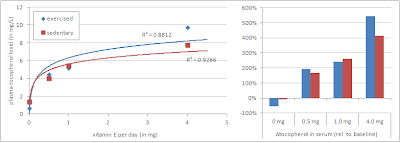 |
| Image 1: If you plan to eat the stuff on the plate behind the coffee cup, I guess it does not really matter if you use sugar, fructose, Aspartame, Acesulfam K, Sucralose or everybody's new darling, stevia to sweeten the coffee ;-) |
If there was a yearly top 10 list of the furiously and most passionately debated topics, in the health & fitness community, the issue of "artificial sweeteners" (personally I would include high fructose corn syrup as "artificial", but I guess the FDA or rather their financiers think otherwise) would probably make it to the TOP 5 every year. All concerns about toxicity issues aside, the
two main concerns people are worrying about are a direct negative effect on glucose metabolism and an indirect intake on subsequent / concurrent food intake. Both would obviously predispose consumers who buy respective products because they trust in the industry's promise that they would help the lose weight and/or ward off diabetes to the exact ailments they are intended to prevent.
Sweet taste receptors are all over the place!My personal interest in this topic has always revolved around the issue of "sweet taste receptors" (i.e. cells that will recognize certain molecules as being sweet), the existence of which in / on all sorts of organs / tissues scientists had been overlooked for decades. I mean, isn't it revealing that
the same "sensors" that are responsible for the sweet sensation you experience when you spooning your delicious full-chocolate ice cream are also present in your gut and even on your pancreas, where their activation sets the stage for the release of insulin into the bloodstream (
Nakagawa. 2009)? This rather recent revelation
could after all finally explain the early results of Blundell et al. who observed an increase in calorie consumption in subjects after consumption of foods containing the artificial sweeteners
Aspartame and
Saccharin (Coke light & Co), back in the fat-phobic 1980s (
Blundell. 1986;
1989). Subsequent more sophisticated studies were yet unable to reproduce those early results (at least in humans).
Artificial sweeteners are obesogenic! Bitter truth or just another myth? With the advent of a more sophisticated understanding of the complex physiological processes and integrated signaling systems which regulate appetite and satiety in mammals and humans in particular (I doubt we will ever be able to understand all the psychological factors that come into play with the latter), Robert E. Steinert and his colleagues from the Clinical Research Center at the
University Hospital in Basel (
Steinert. 2012), Switzerland, took another, more closer look at what actually happens, when we consume beverage which taste as if they contained tons of sugar, but are totally devoid of nutrients.
 |
| Figure 1: Intensity of sweetness, total amount per 250ml solution and energy equivalent of the five sweet test solutions (the sixth beverage was plain water); mind the logarithmic scale! (data adapted from Steinert. 2012) |
To this ends, the Swiss scientists recruited 12 healthy, non-smoking volunteers (6 men, 6 women; mean age 23.3y; normalweight, BMI 23kg/m², min. 3 months of stable weight) to perform a randomised, placebo-controlled, double-blind, six-way cross-over trial. In each of the 6 trials, which were seperated by 3-5d the subjects reported to the lab at 8:00am after an 10h overnight fast (no alcohol, no exercise, no supplements or medication), where they received one (on each occasion) out of six 250ml test solutions containing either tap water (no problem to drink that, in Switzerland ;-), or freshly prepared solutions with concentrations of the different sweeteners, of which the scientists state that they "were
comparable with the amounts found in commercially available beverages and soft drinks" (
Steinert. 2012; cf. figure 1).
Note: I guess I should mention that the test beverages were administered via an intranasal feeding tube. I honestly have no clue, why the scientists chose this method over the natural route through the mouth. After all, this reduces the real world significance of their results. If, for example the sweet taste receptors in the oral cavity (which were obviously bypassed by the intranasal feeding tube) are hard-wired to the brain, while those in the gut are not, this would not only influence the "psychological" aspect of satiety, but could also induce hormonal, i.e. physiological effects... but hey, who am I to criticize the professionals? After all I am only a stray physicist in the realms of nutrition and exercise science ;-)
The intranasal feeding tube was removed immediately after the administration of the respective test beverages. Blood was drawn at regular time intervals at 5, 10, 15, 20, 30, 45, 60, 75, 90 and 120 min and the subjects were asked to rate their hunger, satiety and fullness on a visual analogue scale.
No insulin response, no glucose response to any artificial sweetenerBefore we get to the significant findings, I want to address the often touted insulinogenic effect some of the artificial sweeteners are supposed to have... let me make it short and concise, so that everyone can understand it: There was NO insulin response to ANY of the ARTIFICIAL SWEETENERS!
 |
| Figure 2: Glucose and insulin response to glucose and fructose sweetened beverages; there were NO changes in either glucose or insulin in response to the artificially sweetened beverages (adapted from Steinert. 2012) |
If you scrutinize
figure 2 you will notice that I did not even bother to plot the "straight" lines for either
Aspartam, Acesulfam K, or
Succralose. The reasons for me to include the glucose and insulin responses, at all, were that...
- there was a minimal yet statistically non-significant increase in both blood glucose as well as insulin levels in response to the fructose sweetened beverage, and
- there was a huge +/- 20µU/ml (=20%!) standard deviation for the insulin response to glucose at the 20min mark.
While the former, i.e. the fructose induced increase in both blood glucose and insulin is probably a result of gluconeogensis in the liver, the latter, i.e. the
huge inter-individual variation with respect to the amount of insulin that was released to a standardized beverage, which contained 50g of glucose, goes to show you how large the discrepancies wrt "insulin tolerance / resistance" actually are, even in otherwise healthy young individuals.
Sweetness alone is not satiating - neither "hormonally", ... Apposite to the previously established non-insulinogenic effects of the three artificial sweeteners in the study, neither
Aspartame, nor
Acesulfam K or
Sucralose led to increases in the
glucagon-like peptide-1 (GLP-1, cf.
figure 3), which is involved in the so-called "incretin effect". The latter is responsible for the more pronounced insulin response to an oral vs. an intravenous glucose load and is ascribed to the presence / release of GLP and GIP in the gut.
 |
| Figure 3: Area under the curve (AUC) and maximal value (Cmax) of GLP-1, PYY and Ghrelin in response to the administration of the six test beverages; values expressed relative to water = control (data calculated based on Steinert. 2012) |
In a similar vein, the administration of the artificially sweetened beverages increased neither the "satiety hormone"
peptide tyrosine tyrosine (PYY) nor the "hunger hormone"
ghrelin over the levels the scientists observed for the control beverage which contained plain water, relative to which the values in
figure3 are expressed. Glucose and fructose, on the other hand, led to large and small increases both the area under the curve (AUC,
figure 3, left) and the maximal expression (Cmax,
figure 3, right) of GLP-1 and PYY, as well as corresponding decreases in ghrelin. Accordingly, Steinert et al. conclude:
We infer from these obser- vations that sweetness per se is not sufficient to stimulate the secretion of these peptides in humans. Additional chemosensory mechanisms directed towards the structural integrity of the glucose molecule (as one of the major fuels for the body) must exist including active transport systems. Finally, potential energy-sensing mechanisms or energy thresholds might exist for the secretion of GLP-1 and PYY, although it is unlikely that the release is directly related to the energetic load in a dose–response manner.
And if we were all nothing but hormonally controlled machines, I guess this would be the end of today's blogpost, but since we are not, it is probably prudent to look at the subjective hunger, satiety and fullness ratings of the study participants before we settle this case.
... nor "psychologically", and in fact, it could even make some people hungrier!If we had to make prediction based on the hormonal data Steiner et al. collected, what would you say, which group will feel the most satiated and the least hungry? What? The glucose group? Why? Because they consumed the largest amount of calories? But what about the insulin spike? Well, I guess, it is pointless to continue this feigned dialog... so, let's just take a look at the actual results:
 |
| Figure 3: Time (in min) until hunger, satiety and fullness after ingestion of the six test beverages returned to baseline; statistical averages, left; median, right (data adapted from Steinert. 2012) |
I guess, the results won't please everyone out there, after all fructose, which has as of late been deemed responsible for whatever ailment our obesity ridden society is suffering from, induced the most profound (=long lasting) satiety effect.
Fructose reduced the hunger longer than any other sweetener and the subjects felt full for a longer time period after the ingestion of the fructose-sweetened beverage than after
any other sample.
A brief note: Maybe I can calm the followers of Dr. Lustig down, if I remind them of the way fructose is metabolized? Remember? Fructose is largely being processed into triglycerides by the liver. Now, the latter obviously are fats and I guess nobody will challenge the satiating effects of fat, these days, right?.
With the glucose beverage taking a close second and only non-significant (you know "statistically" ;-) differences to the artificial sweeteners, Steinert et al. thusly summarize their results as follows:
The appetite profile revealed that the (energy-containing) carbohydrate sugar loads induced the longest-lasting increase in fullness ratings above baseline, which was prolonged for fructose 108·4 (SEM 6·1) min and for glucose 90·5 (SEM 11·2) min. In contrast, water (74·0 ( SEM 13·4) min) and the AS [artificial sweeteners] acesulfame K (65·6 (SEM 15·8) min), aspartame (83·1 (SEM 15·9) min) and sucralose (65·3 ( SEM 14·1) min) induced shorter augmented fullness above initial ratings. However, due to the large data variability, these differences did not reach statistical significance. Satiety and hunger ratings showed similar trends, however, with generally smaller differences. Overall, the AS increased satiety and fullness and reduced hunger ratings to an amount that was intermediate between the carbohydrate sugars and the water control.
Now, the SuppVersity would not be
the place to go to read about the latest studies, if I would content myself with someone else's analysis of data that has already undergone a selection process, in the process of which the individual responses got lost. If we do yet take a look at the difference in mean (i.e. the statistical average;
figure 3, left) and median (which is the median value in an ordered list;
figure 3, right) time it took for the hunger, satiety and fullness ratings to return to baseline, we have - yet again - enough evidence for the presence of a
huge interpersonal variability.
 |
| Figure 4: Ratio of the statistical averages and the respective median time until the hunger, satiety and fullness ratings returned to baseline after ingestion of the six test beverages. |
If we take the ratio of the average to the median as an obviously very unreliable marker of this inter-personal variability (I plotted the respective values for you in
figure 4). It becomes obvious that
Acesulfame K, which is the sweetener most companies who pride themselves of not using Aspartame put into their products, could in fact be a wolf in sheep's clothing. While the low median satiety scores in
figure 3 (right) already suggested that it must have been significantly less satiating than plain water, let alone the other sweetened beverages, for some of the subjects, at least, the alternative representation of the data as the ratio of the average to the median in
figure 4 reveals how pronounced this effect actually is.
"So, tell me: What's the unsatiating truth now?"
In spite of the fact, that I do believe that the concerns about potential insulin spikes from foods / beverages which are sweetened with artificial sweeteners
only is unwarranted,
the large intra-individual variation of the satiety effects of the Acesulfam K should raise your awareness of your individual response to artificial sweeteners, in general, and anything that contains
Acesulfam K, in particular. If you feel that respective foods make it difficult for you to stick to your diet, just don't eat / drink them! If, on the other hand, the 1l of Coke light you consume during your fast (just an example ;-) does not make you hungrier than the same amount of water and you are not worried about the fact that rats develop cancer when you feed them with amounts of Aspartame that would equal the consumption of several truckloads of diet coke per day (and that over weeks or months), don't bother and stick to what works for you...
If you do however have trouble sticking to your diet, cannot lose weight or have existing blood sugar issues,
don't use the results of this study as an excuse for your unwillingness to (at least try to) go without your beloved diet Coke for at least a month to see whether or not the latter is not part of the underlying physiological (and psychological) causes of your misery!









































